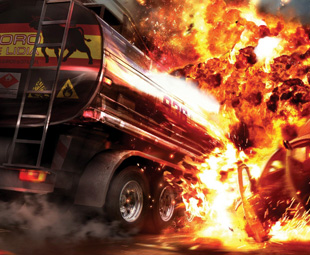An explosive situation?

Increasingly, the transport industry is required to adhere to strict health, safety and employee well-being policies. With a vehicle carrying explosive materials blowing up after an accident on a highway recently, FOCUS asks: To what extent are transport companies actually complying with legislation around the carrying of such hazardous freight?
On February 27, a truck carrying explosive cartridges was hit by a grocery truck on the N1 between Mokopane and Polokwane during the early hours of the morning. A resultant fire caused the truck’s dangerous cargo to explode, killing five people on scene, injuring three others and damaging nearby vehicles. The blast was reported to be so powerful that it ripped a crater in the road and send debris flying for 300 m.
“The truck was hit by another truck – the truck in question was not doing anything wrong. It had broken down and had already been attended to by police officers,” explains Gavin Kelly, technical and operations manager at the Road Freight Association (RFA). “Vehicles carrying dangerous goods, depending on their class, have restricted travelling times.”
Thankfully, while we see and hear of truck accidents on a daily basis (and sometimes they are very deadly …), incidents similar to this tend to be comparatively few and far between. “There are cases, such as this, where the vehicle would still be on the road outside of the specified travelling time,” Kelly cautions. It would seem then that, while the dangerous goods and hazchem sectors of our industry have their act together on the whole, there is still more to be done to further prevent the road-based transport of these goods from turning into an explosive and deadly situation.
Kelly is quick to point out that it is not necessarily the transportation of the cargo that is dangerous, but the nature of the cargo itself. As such, no support vehicles are required, as would be the case when transporting abnormal loads.
Deidre Penfold, executive director at the Chemical & Allied Industries’ Association (CAIA), says that the legislation applicable to the transportation of dangerous goods also applies to explosives (which are Class 1 dangerous goods), specifically the packaging, marking and labelling. In this case, South African National Standards (SANS) 10228 and SANS 10229 apply, both of which are a legal requirement under the National Road Traffic Act and Regulations.
 For the transportation of such cargo, operators must be registered as a dangerous goods operator with the relevant government department and must ensure that a valid dangerous goods operator card is displayed on the vehicle used. “The Chief Inspector of Explosives (CIE) licenses all vehicles transporting explosives on public roads,” says Penfold, “but the operator must also ensure that the driver of a heavy vehicle transporting dangerous goods is in possession of a valid professional driving permit (PrDP-D) and is trained on an annual basis by an accredited provider.” Drivers must always be fit to drive as stipulated in SANS 10231, and must also undergo a medical examination every two years before they can obtain a PrDP-D licence.
For the transportation of such cargo, operators must be registered as a dangerous goods operator with the relevant government department and must ensure that a valid dangerous goods operator card is displayed on the vehicle used. “The Chief Inspector of Explosives (CIE) licenses all vehicles transporting explosives on public roads,” says Penfold, “but the operator must also ensure that the driver of a heavy vehicle transporting dangerous goods is in possession of a valid professional driving permit (PrDP-D) and is trained on an annual basis by an accredited provider.” Drivers must always be fit to drive as stipulated in SANS 10231, and must also undergo a medical examination every two years before they can obtain a PrDP-D licence.
Kelly notes that, in the case mentioned, it would seem that these stipulations were followed. But, to what extent do transporters actually comply with these laws? “Without details on prosecutions, this is unknown,” he says. “The problem of compliance rests with effective policing.” Kelly also notes that, while RFA members are required to be fully compliant, most other reliable and reputable operators seem to be compliant. Likewise, he says, when it comes to the safety, health and well-being of their employees. “In general, transporters do take this seriously; it’s the effectiveness of the labour authorities to monitor this that is of concern.”
Penfold adds: “Companies that undergo regular SA Safety and Quality Assessment Systems (SQAS) audits, of which some are Responsible Care signatories, take it seriously.” This audit assesses the quality, health, safety and environmental performance of logistics service providers in a uniform manner, by means of a single standardised assessment carried out by independent third-party auditors. Responsible Care signatories that offer dangerous goods for transportation should only use logistics service providers that have successfully completed the SA SQAS audit.
“There are many transporters who spend time, effort and financial resources to ensure the safety of their employees and the general public,” Kelly says. Many subscribe to CAIA Responsible Care Guiding Principles and implement Management Practice Standard. The RFA supports the CAIA and facilitates training in this regard.
But, anything from lack of awareness and training to blatant and wilful disregard of the legal requirements are what Kelly says could be reasons for non-compliance. And it is difficult to hold these people accountable, he notes, as the operator, driver, consignor and consignee each have a role to play. “If there are cracks or breaches in the responsibility chain, it becomes very difficult to hold anyone accountable.”
It’s a problem both Kelly and Penfold say needs to be corrected with proper law enforcement. “External factors such as road maintenance and law enforcement will contribute to safer conditions and more respect for the law. The appropriate training of law enforcement officials is imperative,” says Penfold. Kelly continues: “Like any incident, good investigation into the origin of the offence and the cause of the incident needs to be undertaken – followed by sound policing and prosecution, to ensure proper identification of the guilty parties and the handing down of proper sentences. Currently this does not happen.”
Of course, this is also an issue concerning the bottom line – cutting corners may save a quick buck, but investment in one’s people and procedures can have far greater returns.
“Companies should value their drivers and manage them well via various wellness and behavioural-based safety programmes. They must monitor driver hours carefully, ensure they are well trained regarding the properties and hazards of the dangerous goods that they are transporting, perform pre-route risk assessments and ensure drivers get rest,” Penfold advises.
In doing so, Kelly notes, there needs to be far better control of the industry through its own processes. It’s then that we’ll begin to see a true improvement in the safety and well-being of drivers (both those that do and do not transport dangerous goods) and other road users.
Published by
Focus on Transport
focusmagsa




